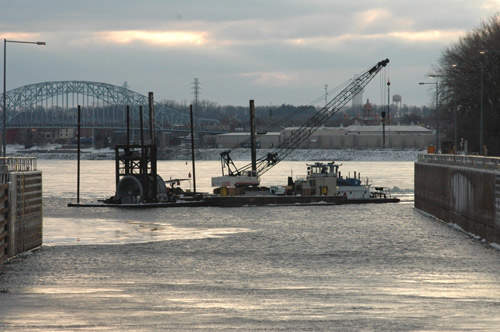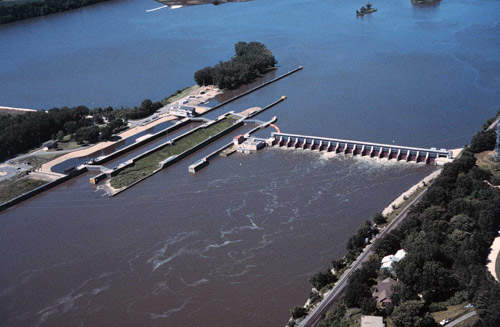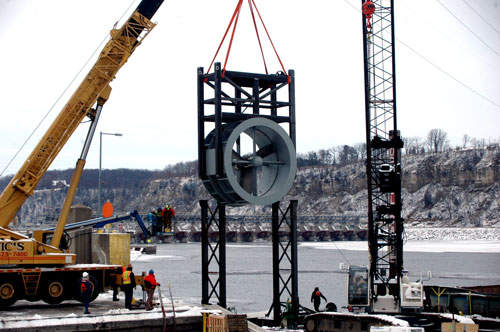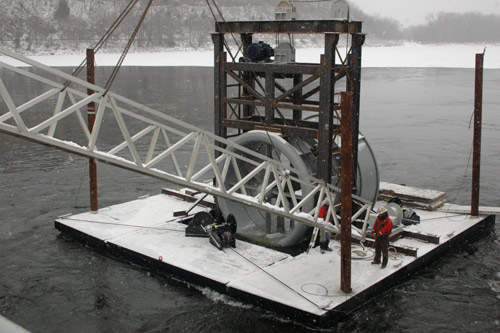The Hastings hydrokinetic power station on the Mississippi river, Minnesota, USA, is the first-of-its-kind barge-mounted power project in the US to receive a federal licence. The power project includes two turbines installed downstream of an existing 4.4MW run-of-river hydropower plant. The power plant is located at the US Army Corps of Engineers (USACE) Lock and Dam No 2.
Hydro Green Energy (HGE), the developer of the technology, will be responsible for the operations and maintenance of the turbines. The project was implemented by the company in partnership with the City of Hastings. It has the ability to increase the renewable power generation capacity at the existing power plant by 5.7%.
The HGE project received approval from the Federal Energy Regulatory Commission by a 5-0 vote in December 2008. USACE approved the project in November 2008 after considering matters pertaining to engineering, safety and operations.
The first of the two turbines installed in the Mississippi river started its commercial operations on 20 August 2009. It was installed at the end of December 2008. The 100kW nameplate-rated hydrokinetic turbine is designed for uninterrupted 24/7 power generation. The second turbine to be installed later in 2009 will be more efficient and have an increased output power of 150kW.
Plant details
The project is located along the upper Mississippi river, upstream of Hastings in Minnesota. The Lock and Dam No 2 was built in 1930. A second lock was built in 1948 due to lock walls’ tilt and settlement. The site was rehabilitated during 1987 and 1995.
The Mississippi Valley Division of USACE St Paul district operates the 110×600ft (34×183m) lock. The 722ft concrete dam includes 19 tainter gates, each 30ft long, and the hydropower plant, which is operated by the hydropower department of Hastings.
The powerhouse at the site has two turbines and generator units with a power generation capacity of 2.2MW each, and a 1,000ft-long transmission line. It lies in-between the dam on the east and the lock system on the west.
The hydrokinetic power station is mounted on a barge downstream from the turbines of the existing hydropower plant to produce additional clean power within the existing plant’s footprint. The units of the power station are designed to have a lifespan of 20 years.
Technology
The hydrokinetic energy generates power by the rotation of turbines installed under the water surface using the natural velocity of the water currents. The technology generates electricity without wasting the mechanical energy of the water flow.
HGE has broadly patented the hydrokinetic technology with US no 6955049 and four foreign patents. The deployment of turbines downstream from the existing hydropower facilities is named as Hydro+, which means incremental hydropower.
The hydrokinetic power station consists of modular, interchangeable and zero-head turbines, a 68ft-wide and 20ft-long floating barge through which the turbines are suspended, generating units atop the barge and a power transmission line that connects the existing powerhouse’s transmission line. The floating barge is also anchored for stability.
Environment
The hydrokinetic power generation does not have any carbon emissions or air or noise pollution. The technology does not have any effect on the dissolved oxygen or water chemistry.
Environmental consulting firm Normandeau Associates conducted the first direct fish survival study on the turbines’ effect on fish in June 2009. The pre-installation computer modelling conducted by HGE resulted in approximately 97.5% of fish survival. Real world data showed a survival rating of over 99% for fish.
Implementation of the power station on a floating raft minimises its impact on riverbeds. The plant is based in the Mississippi river and on the unit of national park system The Mississippi National River and Recreation Area.







